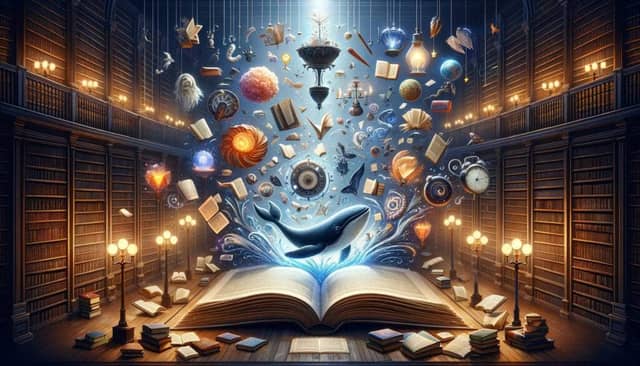Table of Contents
What does 3rd person omniscient mean is a question that often pops up when discussing the art of storytelling. This narrative perspective is like having a bird’s eye view of a novel’s world, where the narrator knows all the secrets, thoughts, and emotions of every character.
Using a 3rd person omniscient point of view allows writers to create complex tales with multifaceted characters. It enables the narrative to explore different angles and depths that other perspectives might not reach.
This narrative style holds a unique power to connect readers with the story on multiple levels. As we unpack what 3rd person omniscient means, we’ll discover how it shapes our understanding and enjoyment of literature, providing a richer, more rounded experience of the narrative world.
What Does 3rd Person Omniscient Mean

When we talk about what does 3rd person omniscient mean, we’re diving into a cool way of telling stories. Imagine if you could know everything about everyone in a story – what they’re thinking, feeling, and all the secrets they’re keeping.
That’s what it’s like when a story is told from the 3rd person omniscient point of view.
In this style, the storyteller isn’t just watching the story unfold from the outside; they know everything that’s happening everywhere. They can tell us what’s going on in the minds of all the characters, not just one.
They can also share details about the past, present, and future, no matter where it’s happening. It’s like having a superpower where no part of the story is hidden from you.
This means that when you’re reading a story told this way, you get to see the big picture. You’re not just following one person’s journey; you’re getting insights into everyone’s lives and all the places they go.
It makes the story richer and gives you a deeper understanding of everything that’s happening.
Characteristics of a 3rd Person Omniscient Narration
One of the coolest things about a story told by a 3rd person omniscient narrator is that the narrator can let you in on what any character is thinking or feeling at any moment.
It’s like being able to read everyone’s mind. Whether it’s a main character or someone who just pops in for a scene, the narrator can share their innermost thoughts and feelings with us.
This helps us understand why characters do what they do and how they really feel about what’s happening around them.
Another awesome feature of this kind of storytelling is how the narrator can take us anywhere in the story’s world, anytime they want.
They can jump from what’s happening today to something that happened ten years ago, or zoom out to show us what’s happening in a different part of the world, then come right back to where we were.
This moving around in time and space makes the story more interesting and gives us a fuller picture of everything that’s going on.
Advantages of Using 3rd Person Omniscient

Using a 3rd person omniscient viewpoint lets the story become richer and more complex. Think of it as being able to watch a movie with the ability to see and hear everything about every character, not just follow one person around.
You get a fuller, more colorful picture of the world the story is set in. Every little detail and background story can be shared, making the whole thing feel more alive and real.
Another great thing about this perspective is how it gives us a fair look at everything. Since the narrator knows everything about everyone, they can tell the story without taking sides.
This means you get to see all the different sides of a story, not just what one character thinks or believes. You get to see the whole picture in a way that’s clear and unbiased.
This helps us understand the characters and their actions better because we’re getting the full story, not just a slice of it.
Challenges of Writing in 3rd Person Omniscient
Writing in 3rd person omniscient can be a bit of a juggling act. One challenge is making sure your readers don’t get lost when the story hops around between different characters.
Imagine being in the middle of a conversation with one character, and suddenly, you’re thrown into the thoughts of someone else in another place.
It can be confusing if it’s not done smoothly. It’s like trying to watch multiple TV shows at once; if you’re not careful, it’s easy to lose track of what’s happening.
Then, there’s the issue of keeping things exciting and making readers feel close to your characters. When you know everything about everyone, it can be tough to keep some secrets for those big, surprising moments.
Suspense thrives on not knowing what’s going to happen next, but if the narrator is always spilling the beans, where’s the mystery?
Also, when you’re dipping into the minds of many characters, it can be hard to form a deep connection with just one. You might know a little about a lot of people, but it’s hard to get super close to anyone.
3rd Person Omniscient vs Other Points of View

When you compare 3rd person omniscient to 1st person and 3rd person limited, it’s like looking at different camera lenses for a movie. Each one shows the story in a unique way.
- 1st Person Perspective is like putting on a GoPro camera on the main character’s head. You see everything from their eyes, hear their thoughts, and feel their feelings. It’s super personal and lets readers get really close to the character. But, just like wearing blinders, you only get to see and know what the main character does. 1st person perspective is great for stories that really want to dive deep into a character’s personal journey or inner world.
- 3rd Person Limited is a bit like zooming out with your camera. You still follow one character closely, but you also get to look around a bit more. You know what they know and feel what they feel, but you’re not locked into their head. It’s a good middle ground, offering some of the closeness of 1st person while allowing the writer a little more freedom to describe things the main character might not notice. 3rd person limited is perfect for stories focusing on a single character’s experience but also want to paint a broader picture of the world around them.
- 3rd Person Omniscient, on the other hand, is like flying overhead with a drone camera. You can see everything and know everything. This perspective lets you explore every character’s thoughts and feelings and jump around in time and space. It’s awesome for big, complex stories with lots of characters and moving parts because it lets the writer give a full, panoramic view of the narrative world.
Choosing the right perspective depends on what kind of story you’re telling. If you want to get really personal and dive deep into one character’s head, 1st person might be the way to go.
If your story is more focused on a single character but you want the flexibility to describe the world beyond their perspective, 3rd person limited is a great choice.
And if you’re spinning a vast, complex tale with many characters and plots, 3rd person omniscient gives you the freedom to cover it all.
Tips for Writing in 3rd Person Omniscient

Here are some tips to keep you on course without swamping your readers with too much information.
- Introduce Characters Gradually: Don’t throw every character’s deepest thoughts and backstories at your readers all at once. It’s like getting to know people at a party; if you try to learn everything about everyone in the first five minutes, you’ll end up remembering nothing. Introduce characters and their inner worlds slowly, giving your readers time to get acquainted.
- Keep Transitions Smooth: When shifting focus between characters or scenes, think of it as changing lanes on a highway. You don’t want to jerk the wheel and send everyone flying; signal your intentions and make the change smooth and clear. Use chapter breaks, section dividers, or even just a well-placed paragraph break to help your readers follow along without getting lost.
- Use a Consistent Narrator’s Voice: Even though you’re dipping into the minds of various characters, keep the narrator’s voice consistent. This doesn’t mean you can’t adjust the tone to fit the moment, but there should be a steady presence behind the storytelling. It’s like having a trusted guide on a tour; even if you’re exploring different places, the guide’s familiar voice keeps you grounded.
- Balance What You Show and Tell: Just because you can share every character’s thoughts doesn’t mean you always should. Sometimes, it’s more powerful to show a character’s actions and let readers infer what they’re thinking or feeling. It’s the difference between giving someone a fish and teaching them to fish; one feeds them for a day, but the other engages their mind.
- Keep the Big Picture in Focus: Always remember the overall story you’re trying to tell. It’s easy to get caught up in the details of each character’s thoughts and lose sight of where your story is heading. Think of it as planning a road trip; you might take some scenic detours along the way, but you should always have your final destination in mind.
By following these tips, you can harness the power of 3rd person omniscient narration to craft rich, engaging stories that captivate your readers without overwhelming them.
Use AI Automateed
If you’ve got lots of ideas but no time or you’re not sure how to start writing a book, there’s a cool tool called AI Automateed that can help.
This tool is like magic – it can write a whole book for you in just a few minutes. You just tell it what your book’s about, who you’re writing it for, and how you want it to sound, like talking to a friend, or telling a story, or 3rd person omniscient.
AI Automateed does all the heavy lifting. It plans out your book, then writes it with everything you need, like pictures, a cover, and a table of contents.
And it’s all yours – no one else will have a book like it. There’s even a video you can watch to see how easy it is:
The best part? You can try it out without paying a penny.
Plus, this tool isn’t just for writing books. It can also help you come up with book titles, write stuff for YouTube, make social media posts, and lots more.
So, if you’ve ever wanted to write a book but didn’t know where to start, AI Automateed might be just what you need.
Examples in Literature

Here are some shining examples of 3rd person omniscient narration that show us just how powerful this perspective can be.
- “War and Peace” by Leo Tolstoy: This classic novel is a titan of the 3rd person omniscient style. Tolstoy takes us through the lives of multiple characters, ranging from the Russian aristocracy to the common soldier, against the backdrop of the Napoleonic Wars. By dipping into the thoughts and feelings of a wide cast, Tolstoy paints a rich, detailed picture of society, war, and humanity. It’s like having a bird’s-eye view of history, seeing how individual lives weave together to form a larger tapestry.
- “Middlemarch” by George Eliot: In this novel, Eliot uses the 3rd person omniscient voice to explore the lives, ambitions, and follies of the inhabitants of a fictional English town. The narrator’s ability to delve into the inner workings of each character’s mind creates a vivid, multifaceted view of Victorian society. It demonstrates the narrative’s power to provide a comprehensive understanding of human nature and social dynamics.
- “The Hitchhiker’s Guide to the Galaxy” by Douglas Adams: While a departure from the serious tones of Tolstoy and Eliot, this science fiction classic showcases the versatility of the 3rd person omniscient perspective in a more humorous and whimsical setting. Adams’ narrator zips around the universe, sharing insights into characters’ thoughts, the history of galactic civilizations, and the peculiarities of interstellar travel. It’s a great example of how this narrative style can be used to blend plot, exposition, and humor seamlessly.
These books exemplify how the 3rd person omniscient point of view allows authors to create complex, deeply interconnected worlds.
Through this lens, readers gain a comprehensive understanding of the story’s environment, the interplay between characters, and the broader themes at play.
Conclusion
Exploring what does 3rd person omniscient mean reveals a narrative style that offers unparalleled depth and breadth in storytelling. This approach allows writers to craft complex, richly detailed worlds, providing readers with a comprehensive view of the characters’ thoughts, feelings, and the story’s setting.
Writers must navigate the challenges of maintaining clarity and coherence while offering readers the broad, all-encompassing perspective that defines this style. For readers, this means engaging with stories that offer a multifaceted exploration of characters and their environments, making for a more immersive and rewarding reading experience.
FAQ
What is an example of 3rd person omniscient?
An example of 3rd person omniscient is “War and Peace” by Leo Tolstoy. In this narrative style, the author has the freedom to explore the thoughts and feelings of any character, offering readers a comprehensive view of not only the individual’s inner world but also the broader societal and historical context.
What does 3rd person limited mean?
3rd person limited means the story is told from the perspective of an outside narrator who focuses on the thoughts and feelings of only one character. Unlike omniscient narrators, this perspective limits the reader’s knowledge to what the chosen character knows, sees, and experiences, creating a more intimate but narrower view.
What words are 3rd person omniscient?
In 3rd person omniscient narration, the narrator uses third-person pronouns like “he,” “she,” “they,” and “it” to describe characters and actions. However, unlike 3rd person limited, the omniscient narrator also provides insights into the thoughts and feelings of multiple characters, not just one.
Is 3rd person omniscient bad?
No, 3rd person omniscient is not bad; it’s a narrative choice that offers its own unique advantages. This perspective allows for a broad and deep exploration of the story’s world, offering insights into multiple characters and events. The key is using it skillfully to avoid overwhelming or confusing the reader.
Is third person omniscient rare?
Third person omniscient is less common in contemporary literature than 1st person or 3rd person limited perspectives, but it’s not rare. It has been used effectively in many classic and modern works to provide a wide-ranging viewpoint that can enhance the storytelling experience.
Why is third person omniscient good?
Third person omniscient is good because it allows for a comprehensive exploration of the narrative, giving readers insight into multiple characters’ thoughts and motivations. It enables the writer to create a more detailed and complex story world, enriching the reader’s understanding and engagement with the story.
Who can be omniscient?
In a 3rd person omniscient narrative, the narrator is the omniscient entity, not a character within the story. This narrator knows everything about the story’s world, including the thoughts, feelings, and backgrounds of all characters, as well as events that have happened, are happening, or will happen.



